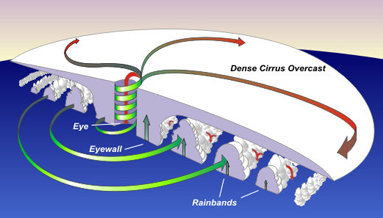Giant waves are pictured in this photo. Waves like this caused by Hurricane Georges could swamp some of the Florida Keys. The hurricane already hit some Caribbean islands with 20-foot waves and storm surges 5 to 10 feet above normal tides. These swells can affect boaters and sailors very far from the eye of the hurricane.
Click on image for full size
Courtesy of Corel Photography
The Latest on Hurricane Georges
News story originally written on September 25, 1998
Hurricane warnings were posted yesterday for much of Southern Florida. More than 1 million people were ordered to evacuate the area from Key West to Tampa.
The eye of the hurricane was expected to pass just south of Key West today by 11 a.m. EDT. Winds are over 100 miles per hour and many in Florida have already experienced power outages. Damage to property and a possible death toll will be known only after Georges has passed the Keys later tonight. After passing the Florida Keys, the hurricane is expected to strengthen to a category 3 storm. It could be a threat to the northern Gulf of Mexico by Saturday.
Georges was once a major hurricane, until it ran into the Caribbean Islands. These Islands acted to slow the hurricane down, keeping it as a category 1 on the Saffir-Simpson scale. This was all tragic news to residents of the Lesser Antilles, Puerto Rico, the Dominican Republic and Haiti. Over 250 people have been killed by the hurricane's trek across the Caribbean.
You might also be interested in:

As a strong hurricane heads towards a vulnerable coast, people take precautions - boarding up houses, packing the car, and evacuating. These massive storms can spell disaster for people in hurricane prone
...more
At the center of a fierce tropical storm, there is a small area where the weather is calm, the sky is clear, and the winds are just light breezes. This area is called the eye of the storm. As a hurricane
...more
It was another exciting and frustrating year for the space science program. It seemed that every step forward led to one backwards. Either way, NASA led the way to a great century of discovery. Unfortunately,
...more
The Space Shuttle Discovery lifted off from Kennedy Space Center at 2:19 p.m. EST, October 29th. The sky was clear and the weather was great as Discovery took 8 1/2 minutes to reach orbit for the Unitied
...more
A moon was discovered orbiting the asteroid, Eugenia. This is only the second time in history that a satellite has been seen circling an asteroid. A special mirror allowed scientists to find the moon
...more
Will Russia ever put the service module for the International Space Station in space? NASA officials are demanding an answer from the Russian government. The necessary service module is currently waiting
...more
During a period of about two days in early May, 1998, the ACE spacecraft was immersed in plasma associated with a coronal mass ejection (CME). The SWICS instrument on ACE, which determines unambiguously
...more















